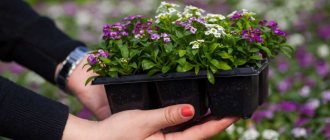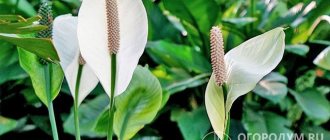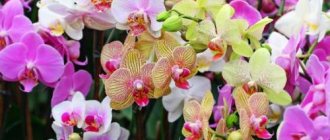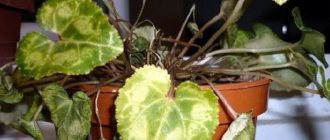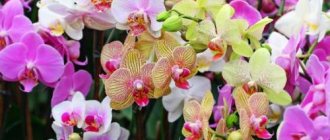Spathiphyllum, popularly called “women’s happiness” or “white sail”, is considered a fairly common houseplant and is found in almost every home. According to legend, a blooming spathiphyllum helps the owner find love or have a long-awaited baby. But sometimes the plant is in no hurry to throw out its buds, forcing you to think about what to do if the spathiphyllum does not bloom.
When and how does spathiphyllum bloom?
Like any other tropical plant, spathiphyllum does not shed its leaves all year round. However, it was not the greenery that gave the flower such popularity. To a greater extent, people like “female happiness” because of its flowering.
Blooming spathiphyllum
Types and forms of flowers
The color of the leaves and the shape of the buds depend on the variety of spathiphyllum. At the moment, botanists have bred more than 40 species of plants, but few of them can be used to decorate an apartment.
- Abundantly flowering. A flower with light green leaves that can reach 20 cm in length. Peduncles rise 20 cm above the foliage. The white perianth is small, reaching up to 8 cm in length and no more than 3 cm in width.
- Nice. The oblong leaves are elliptical in shape and can grow up to 30 cm in length. Bract of light green color. Can reach 20 cm in length.
- Cannofolia. The leaves are dense and narrow, up to 40 cm long. The bract cover has a 2-color color: white on the front side, light green on the back. The bed can reach 22 cm in length.
- Spoon-shaped. The width of the spoon-shaped spathiphyllum leaf is up to 15 cm with a length of 30-40 cm. The bedspread is concave, which resembles a spoon. At the beginning of flowering it is white, but when it begins to fade it turns green.
Spathiphyllum Wallis is valued for its unpretentiousness
- Wallis. The most unpretentious type of plant, and therefore the most popular among domestic housewives. Spathiphyllum is small in size: leaves are up to 24 cm in length, white inflorescence is 5 cm. The bedspread tends to turn green.
- Mauna Loa. The inflorescence is white, wide, elliptical, concave and cream-colored. The leaves are short - up to 5 cm in length. Flowers can be cut and remain fresh for about a month.
- Picasso. Externally, Picasso is considered the most remarkable variety of spathiphyllum. Entire sections of its green leaves are painted white. The perianth and spadix also have a two-color color.
Picasso is perhaps the most notable variety
Flowering duration
Spathiphyllum is a perennial plant, and therefore flowering occurs for the first time after full development. Only in the second year of life does the young flower bloom for the first time. This time may vary depending on the environment and care conditions for the plant.
Budding of spathiphyllum can occur annually, but in some cases it refuses to bloom.
Favorable conditions force spathiphyllum to begin flowering in March. It often lasts until autumn, but it may begin to bloom again towards the end of summer.
Attention! With proper care of the flower, repeated flowering is possible.
What to do if the flower begins to fade
It is impossible to understand the true reason why a flower withers. There are several reasons that cause a plant to wilt:
- The ground freezes. The plant does not tolerate even small drafts and cold. If you water at low temperatures, this will cause hypothermia of the soil. In such a situation, it is necessary to either remove the plant from drafts or cold, or heat the water to the temperature in the room. Frozen soil in a pot will cause the flowering plant's bud to wither.
- Dried soil. The main reason that a flower withers is very dry soil. It is important to regularly water the spathiphyllum, as well as wipe the leaves and spray the flower.
- Cramped pot. A very small pot can cause the flower crop to dry out. It is imperative to replant the flower in the summer into a container that is 30-40 mm larger in volume than the previous one (but not more than 200 mm).
- Parasites. If spathiphyllum is not treated in a timely manner, it is quite possible that the plant will begin to wither. Therefore, when symptoms of the disease appear, it is necessary to urgently treat the exotic plant.
If the causes are eliminated in a timely manner, the flower will definitely bloom. By listening to the advice, you will be able to revive your home flower yourself, and the plant will give you beautiful blooms.
In order for the flowers to be healthy and spectacular, it is necessary to follow the rules of care, watering and fertilizing.
Why does spathiphyllum not bloom, but only produces leaves?
There may be many reasons why spathiphyllum does not bloom. The basis for all is improper care. But even if the owner understands what is wrong with the flower, not every gardener knows what to do in such a situation and how to save the plant.
Incorrect placement of the “female happiness” flower
Why cinquefoil does not bloom - what to feed
Before planting a flower, you should take care of finding a suitable place for it in the house: it must satisfy a number of parameters. First of all, spathiphyllum should not be in a draft. Good lighting is also required. If natural is not enough, it is recommended to use artificial.
Note! Window sills are not always a good solution to the situation: direct sunlight can leave burns on the leaves, and UV radiation destroys the structure, which is why the leaf blade begins to turn yellow.
It is worth carefully monitoring the condition of the flower: if the leaves begin to stretch, changing shape, this means that they do not have enough light. This can also lead to a lack of flowering.
It is not advisable to place a flower pot near radiators and other heaters in winter, since spathiphyllum needs a lower temperature during the dormant period.
The leaves are turning yellow
Low humidity level
Spathiphyllum is an exotic plant whose homeland is in the tropics. At home, you need to recreate approximately the same conditions to make the flower bloom. You can control the humidity level in your apartment using a hygrometer or psychrometer. The problem often arises from central heating as it dries out the air greatly.
Errors in watering
Watering the plant is required no more than 2 times a week. It is necessary to monitor the condition of the soil and carry out the procedure only as it dries. It is also worth wiping the leaves from dust, since without this they may lose their elasticity.
Do not overwater the plant. Improper implementation of the procedure can also affect the condition of the flower. Watering should be carried out with well-settled water at room temperature. In the warm season, it is worth watering more often, and in winter the number of procedures should be reduced.
Excess or deficiency of nutrients
Usually, in order for spathiphyllum to bloom profusely, gardeners begin to feed it intensively. But it is worth remembering that not every fertilizer will be useful for a plant at one time or another. Nitrogen should be used exclusively for growing leaves, and therefore during flowering it can play a cruel joke.
Important! Too frequent introduction of fertilizing leads to the fact that the plant can be poisoned. An incorrectly carried out procedure can cause irreparable damage - the roots will get severely burned.
Incorrectly selected soil composition
The soil for the plant should be slightly acidified. If you want to prepare the substrate yourself at home, then you should take:
- 1 part humus;
- 1 part leaf soil;
- 2 parts wood soil;
- 1 part peat soil.
You can improve it with charcoal. It is important to place drainage at the bottom of the pot.
Pot too big
Another reason why spathiphyllum does not bloom, if it is well cared for at home, may be a pot chosen that is not the right size. Before releasing the peduncle, the plant will try to completely fill the entire space of the container provided to it.
Pot size for spathiphyllum
If you don’t want to wait a long time, you can transplant the flower into a smaller pot. But you shouldn’t do this too often, since this event is very stressful for the plant.
Diseases and pests
If the spathiphyllum begins to grow poorly, the problem may lie in the pests that have inhabited the flower. Frequent guests are scale insects, spider mites and thrips.
Depending on the type of pests that appear, it is worth arming yourself with special products purchased in the store and treating the plants according to the attached instructions.
Pests
@ Yulu stock.adobe.com When infested with mealybugs, a white coating appears on the leaves
A sick plant is simply not able to please its owner with flowering due to lack of strength. The main goal of the plant is to survive, and the gardener’s task is to help it with this. Most often, when growing spathiphyllum, the gardener encounters the following pests:
- Mealybug. Small insects. Their body is covered with white fluff. Most often they attack in colonies, gathering on the underside of healthy young leaves. With massive damage, the leaf blade withers, turns yellow and falls off. Using a magnifying glass, the pest can be examined and removed from the surface of the leaf. Keep in mind that mechanical treatment is not enough; the plant must be treated with a systemic insecticide.
- Spider mite. A small, arthropod-sucking insect, which is very difficult to identify with the naked eye. Most often, a gardener notices a problem after a real web forms on the leaves and petioles. Regular spraying helps prevent damage. If damage occurs, treatment with Aktara is necessary.
- Damage to aphids. Aphids are small insects that are green, black, orange or gray in color. The insect feeds on the sap of plants, their leaves curl, turn yellow and fly off. If the damage is minor, the plant should be washed with soap and then treated with a systemic composition against pests of a wide spectrum of activity.
@ ELENA stock.adobe.com Healthy plant leaf
We recommend watching the following video:
Remember that only a healthy plant can delight its owner with lush, dense greenery and flowering. It is necessary to regularly inspect flower pots for the presence of pests and carry out treatments in a timely manner.
Attention! If the plant was taken out into the garden for the summer, treatment is mandatory. It should be done at intervals of 1 week.
How to make spathiphyllum bloom: tricks
Why does spathiphyllum not bloom at home?
There are quite a few tricks to make spathiphyllum bloom. The main one is shock therapy. It is recommended to place the flower pot in an environment where the air temperature is around 12 degrees Celsius for a couple of weeks, and then return it to the room. After this, buds should appear.
Eliminating care errors
First of all, if the spathiphyllum has begun to wither, it is recommended that you familiarize yourself with the rules for caring for this plant. Depending on the external characteristics of the flower, you need to choose the right place for it in the apartment, where there will be no drafts, humidify the air and remove it away from heating devices.
If the pot or soil composition is incorrectly selected, it is recommended to replant by choosing a smaller pot and carefully shaking the substrate from the roots.
Transplantation of spathiphyllum if necessary
Stimulation of flowering with fertilizers and subcortex
Flower growers need to know how to feed spathiphyllum for abundant flowering. Incorrectly selected fertilizers can promote the growth of new leaf mass, instead of budding. Organic matter is needed only after the end of the dormant period in order to strengthen the root and immune system of the flower.
After this, you should switch to mineral supplements. It is recommended to use complex fertilizers, as they contain a larger amount of nutritional components. However, in the absence of flowering, it is worth knowing what to feed the spathiphyllum so that it blooms. Most often, phosphorus and potassium are used for this.
Attention! You should definitely stop applying nitrogen fertilizers while waiting for flowering.
Purchased funds
It is impossible to say what is better to fertilize plants - purchased or folk remedies. For spathiphyllum, it is recommended to choose any preparation for feeding aroid plants. The most popular means:
- Bona forte;
- chelatin;
- nitrophoska;
- azophoska;
- "Green house";
- "Garden of Miracles"
It is necessary to follow the instructions for use and perform the procedure exclusively using protective equipment.
Folk remedies (sugar, coffee grounds, drunken tea, etc.)
Among the folk remedies you can use the following:
- Tea leaves or coffee grounds. They contain large amounts of oils, microelements and vitamins. It should be dried before applying to the soil.
- Watering with sugar water will activate the vitality of the flower and increase its immunity.
- Banana peels will also help revitalize the plant. It is recommended to cut the fresh ingredient into small cubes and add it to the soil.
Folk remedies are safer for indoor plants than specialized ones, since improper use cannot cause harm.
Banana peel feeding
Replanting a plant with errors
“Women’s happiness” is growing and developing rapidly, and the root system is no exception, which completely fills the pot in a short time. “Women’s Happiness” needs to be replanted on time, the appropriate period is in the spring. Choose a flower pot slightly larger than the previous one.
It is propagated by children. However, the plant does not like forced separation. In order not to harm the entire spathiphyllum, it is better to wait for the baby to fully develop and form into an adult plant. After ripening, the finished plant is transplanted into a suitable pot.
Required size pot
When a specimen is transplanted into a new pot or children are planted, the soil is chosen to be slightly acidic; this will have a beneficial effect on the growth and development of the individual. It is recommended to choose the following mixture: manure and leaf, peat, wood soil in a ratio of 1:1:1:2. Charcoal is also added. A high-quality drainage system is required. To make the soil looser, it is advisable to add rotted wood or coniferous soil. In the case of a dense substrate, there will be poor air circulation, which will cause slow development and lack of flowering.
The flowerpot should be selected for “women’s happiness”; it should not be too large; the roots should not dangle there. Spathiphyllum blooms only after the roots fill the container.
Other possible problems with spathiphyllum flowering and their solutions
Spathiphyllum - propagation at home
Flowering of spathiphyllum may not occur for various reasons. However, the absence of this process is not always the only problem for gardeners who are engaged in growing this plant.
Dropping buds
Spathiphyllum begins to shed buds for 3 reasons:
- insufficient watering;
- water getting on the buds;
- exposure to direct sunlight.
To correct the problem, you just need to eliminate these factors, place the plant in a more suitable place, and also learn how to water the flower correctly.
Flowers grow green
Greening of the inflorescence can occur for natural reasons or as a result of improper care. In the first case, do not be afraid. In the second case, we are talking about the following factors:
- violation of dosages of introduced fertilizers;
- excessive watering;
- fungal diseases;
- excess lighting.
After eliminating the cause of this phenomenon, the plant will again produce inflorescences of its usual color.
Green flowers
Photo
Here you can see a photo of the crop during flowering, which was achieved by following all the rules of home care.
How to care for spathiphyllum after flowering
When the spathiphyllum has faded, it is recommended to carefully cut or remove each flower with your hands.
You should also do heavy pruning immediately to allow the plant to rest during the winter.
It is worth eliminating fertilizing and reducing watering, since this is not necessary during the dormant period. If a transplant is necessary, it is better to do it at the moment.
Spathiphyllum is a fairly popular indoor plant because it is not considered capricious; even novice gardeners can take care of it. The plant feels comfortable on the windowsills of central Russia.
Botanical certificate
Spathiphyllum belongs to the Araceae family, which is widely represented in indoor floriculture. Among its “relatives”: monstera, dieffenbachia, anthurium, zamiakulkas, syngonium, aglaonema, alocasia, caladium, philodendron, scindapsus - inhabitants of tropical and subtropical climates, loving warmth and humidity. All of them are poisonous due to their high alkaloid content.
Aroids are used for landscaping office and home interiors. In addition to the aesthetic component, they are excellent air purifiers from harmful impurities
Basic land requirements
In order to choose the right soil that is needed for spathiphyllum, you need to find out as much as possible about the conditions under which this plant grows in nature. “Women’s Happiness” is a plant of the humid tropics, growing mainly along river banks, next to reservoirs, and in wetlands. The soil in such places is rich in fallen and rotted remains of leaves and branches, as well as peat. Typically, such soil is light, loose and moist. This means that such soil is suitable for an indoor flower.
Also a necessary requirement for “female happiness” is breathability and neutral or weak acidity (ph ~ 5.5) of the soil. To increase breathability, coarse sand is usually added to the soil, and good drainage is used when planting, for which expanded clay, pebbles, and brick chips are used. To reduce acidity, slaked lime, dolomite flour or ash are suitable. And, conversely, to increase the acidity of alkaline soil, peat, leaf humus or ammonia-containing fertilizers are used.
So, for those who love this indoor flower and want the “pet” to bloom actively, it is recommended to use light, loose, humus-rich, moist soil for planting, and also ensure good drainage in the pot.




